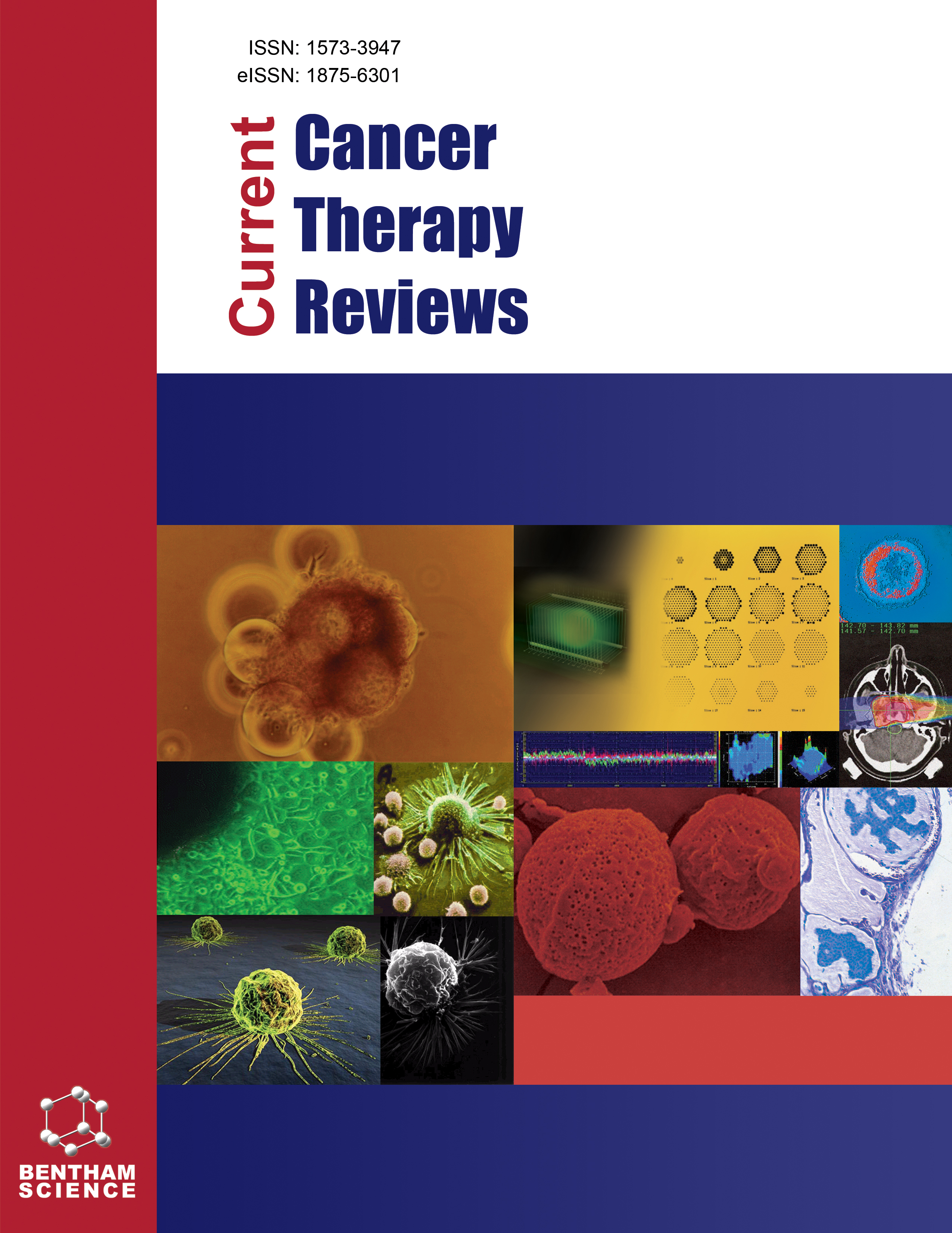- Home
- A-Z Publications
- Current Cancer Therapy Reviews
- Previous Issues
- Volume 6, Issue 3, 2010
Current Cancer Therapy Reviews - Volume 6, Issue 3, 2010
Volume 6, Issue 3, 2010
-
-
Intraductal Papillary Mucinous Neoplasm (IPMN): A Precursor to Pancreatic Cancer
More LessCystic neoplasms of the pancreas account for about 10% of pancreatic tumors. Intraductal papillary mucinous neoplasms (IPMNs) are the most common cystic tumors of the pancreas presenting with no or unspecific clinical symptoms. Diagnosis of IPMNs is challenging and accomplished by CT, MRI, MRCP and EUS. Primarily, IPMNs are regarded as benign cystic lesions, however, almost 60% of resected IPMNs reveal maligna Read More
-
-
-
New Therapies for Prostate Cancer Based on the Biology of Androgen Receptor Coregulators
More LessAuthors: Yuexing Zhang and Anne W. HamburgerProstate cancer is currently the most prevalent cancer among men in the United States and ranks second to lung cancer in terms of annual mortality. The androgen receptor (AR) is central to the initiation and growth of prostate cancer and to the therapeutic response to hormones. Although it has been known for many years that the expression and activity of AR is controlled by AR coregulators, the manipulation of e Read More
-
-
-
Current Treatment Strategies for Hepatocellular Carcinoma
More LessAuthors: Andrew Aronsohn and Smruti R. MohantyHepatocellular carcinoma (HCC) is a leading cause of cancer related death both in the United States and worldwide. Proper management begins with identification of high risk individuals who may benefit from a screening program for HCC, since early detection of this cancer can lead to improved survival. Advances in radiographic technology and new staging systems that take tumor burden and clinical status into accoun Read More
-
-
-
The Role of Image Guided Radiotherapy in the Treatment of Soft Tissue Sarcoma
More LessAuthors: Julie A. Bradley, Kristofer Kainz, X. Allen Li and Dian WangSarcomas are inherently exacting to treat due to the diversity of histology and anatomic locations in which sarcomas may arise. Each anatomic site poses specific challenges for ensuring accuracy of target delineation. Image guided radiotherapy (IGRT) is a technique in which pretreatment images are obtained on a regular basis to evaluate tumor and/or organs at risk (OAR) locations relative to their position on the day of CT Read More
-
-
-
The Role of Oxaliplatin-Based Versus Cisplatin-Based Regimens in Advanced Gastric Cancer: A Systematic Review and Pooled Analysis of the Chinese Literature
More LessAuthors: Fenghua Wang, Fanggong Jiang, Yuhong Li, Ying Guo, Lin Shen and Li ZhangThe prognosis for patients with advanced gastric cancer (AGC) remains poor, and systemic chemotherapy is the main treatment option. Many clinical studies utilizing oxaliplatin-based regimens as first-line treatment for AGC have been conducted by Chinese investigators. However, there is no clear consensus concerning the role of oxaliplatin in AGC in Chinese patients. The aim of the present literature-based meta-analysis Read More
-
-
-
Fungal Secondary Metabolites: A Promising Source of Antineoplastic Drugs
More LessThe rapid progress in understanding the molecular biology of cancer has made a large impact on the design and development of novel therapeutic strategies prompted by the multi-factorial limitations of the current chemotherapeutic modalities. Given that the development of newer antineoplastic drugs continues to rely heavily on isolation from natural sources rather than applications based on rational drug design an Read More
-
-
-
Cutaneous Melanoma: A Test Field for Immunotherapy and a Medical Challenge
More LessAuthors: Mariana Aris, Maria M. Barrio and Jose MordohCutaneous melanoma (CM) is the fourth tumor in frequency, and that whose incidence increases faster. In half of the cases, CM arises from pre-existing nevi. CM is a highly heterogeneous tumor, whose degree of differentiation varies among different hosts, and such heterogeneity is probably based on the accumulation of mutations that determine transitions from normal melanocytic stem cells → mutated benign melanocytic Read More
-
-
-
The Changing Role of Radiation in the Post-TME ERA of Rectal Cancer
More LessAuthors: Lily L. Lai and Charles R. Thomas Jr.Total mesorectal excision (TME) for rectal cancer is now considered standard in the surgical treatment of rectal cancer. The application of this technique has resulted in a pooled pelvic recurrence rate of approximately 7%. Preoperative and postoperative radiation further decreases the local regional recurrence (LRR) rate in patients with rectal cancer but the reduction in risk is counterbalanced by increased short and lon Read More
-
-
-
The Importance and Evolution of Radiation Dose in DCIS
More LessAuthors: Kimberly S. Keene and Jennifer De Los SantosParalleling breast conservation therapy for invasive breast cancers, treatment for ductal carcinoma in situ (DCIS) has followed the treatment paradigm of surgery and postoperative radiotherapy. Randomized studies evaluating the need for radiation therapy following lumpectomy in patients with DCIS from both the NSABP (B-17) and the EORTC (10853) demonstrated a local control benefit that was homogeneous acr Read More
-
Volumes & issues
-
Volume 21 (2025)
-
Volume 20 (2024)
-
Volume 19 (2023)
-
Volume 18 (2022)
-
Volume 17 (2021)
-
Volume 16 (2020)
-
Volume 15 (2019)
-
Volume 14 (2018)
-
Volume 13 (2017)
-
Volume 12 (2016)
-
Volume 11 (2015)
-
Volume 10 (2014)
-
Volume 9 (2013)
-
Volume 8 (2012)
-
Volume 7 (2011)
-
Volume 6 (2010)
-
Volume 5 (2009)
-
Volume 4 (2008)
-
Volume 3 (2007)
-
Volume 2 (2006)
-
Volume 1 (2005)
Most Read This Month
Article
content/journals/cctr
Journal
10
5
false
en


